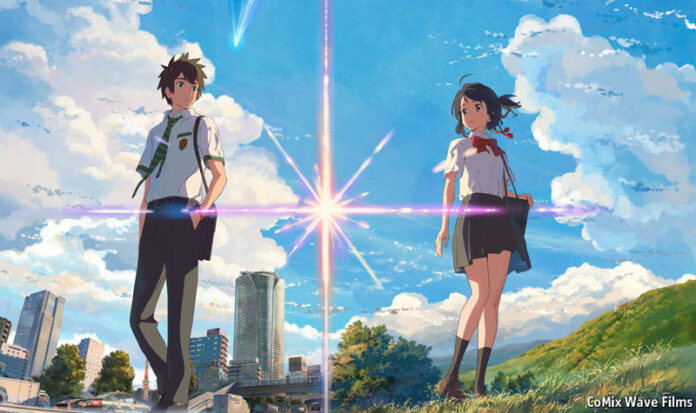Through a series of mystical events, my wife and I attended San Francisco’s 50th Cherry Blossom Festival Parade in Japantown in Sunday’s wind and rain, and watched the Japanese anime’ masterpiece Your Name at the Kabuki theater the same evening.
Refusing to let their spirits be dampened, parade participants used clear plastic garbage bags as make-shift rain ponchos for their drum and bugle corps, beautiful queens surrounded by lovely princesses, politicians in convertibles and floats pulled by brown UPS trucks. Wearing classic Japanese regalia under their rain gear, groups of children, men and women beat Taiko drums, sang songs while playing the samisen, gracefully glided past in ornate costumes, and joined forces to carry the Mikoshi on their shoulders—a portable Shinto shrine weighing over half a ton.
One group of dancers wore the traditional red and white garb of Miko shrine maidens while performing twirling dance steps punctuated by the jingling bells carried in their hands. Coincidentally, in Makota Shinkai’s Your Name, an adolescent girl Mitsuha, dresses and dances the same way.
Mitsuha and her younger sister live with their grandmother in a pastoral mountain village beside a circular lake. Her father, the mayor, is running for re-election and expects his daughters to be especially well-behaved. But fate makes that astoundingly difficult, for inexplicably, one morning, the being occupying Mitsuha’s physical body, is a Tokyo high school boy named Taki, while Taki’s body is occupied by Mitsuha’s soul. The manner in which the two first explore the physical changes to their gender-shifting bodies makes you realize this is nothing like a Disney film.
But the biggest change is to their personalities. Mitsuha stands up for herself, takes greater risks, and sinks a basketball with ease. Taki is more comfortable around women, repairs a co-worker’s ripped skirt with skill and panache, and creates provincial landscapes in his architectural design class.
Taki’s drawings are based on views of Mitsuha’s village—a place Taki has never seen in real life and which Mitsuha can’t wait to get away from. Her dream is to live in Tokyo, and inhabiting Taki’s body, she gets a chance to live there.
Self-taught as an animator, Makota Shinkai learned his craft by watching hundreds of animated movies. The result is on the screen. Your Name is created with the same sense of beautiful wonderfulness of the first feature-length animated film, Disney’s Snow White and the Seven Dwarfs.
The natural landscapes and skyscapes are as finely rendered as the watercolor backgrounds in Snow White, and the buildings, trains, and skyline of Tokyo are as meticulously detailed as Edward Hopper’s photo-realistic paintings. People familiar with Japanese Manga and Anime already know that architecturally detailed drawings are often used to start a chapter and establish a specific sense of place. Your Name’s artists take this trope to an entirely different level. These aren’t just static place-holders, these are lively, breathing, touchable real-life places.
The Freaky Friday-style storyline is misleadingly simple. The fact that an adolescent boy and girl would dream of being somewhere and even someone else is perfectly plausible. The threat to a peaceful Japanese village’s future is as omnipresent as the next tsunami. The belief that our true soulmate exists somewhere, out-there is the basis for all Nicholas Spark’s novels. The media’s prognostications for catastrophic events is as certain as the five day weather forecast for a Cherry Blossom parade. And that doesn’t even come close to considering the Shinto cosmology underlying everything—or the exquisitely detailed observations of simple, everyday things like how a gas flame burns under a frying pan and how the three eggs frying sunny-side up in that pan cook at different rates.
Your Name’s distributor, Funimation has only released this exceptional film in a small number of theaters, so you have to seek it out. It’s worth it. I’d like to watch it again.
Comments? E-mail gi*********@*****st.net









